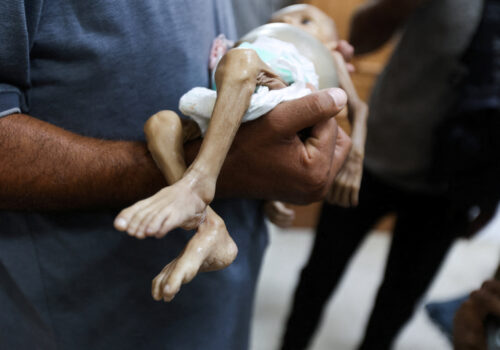A little-discussed point in Trump’s Gaza plan could be an opportunity to build interfaith understanding
Inside US President Donald Trump’s twenty-point peace plan for Gaza is a call, largely unnoticed and buried towards the end of the text, for a new interfaith dialogue between Israelis and Palestinians.
More specifically, point eighteen reads:
“An interfaith dialogue process will be established based on the values of tolerance and peaceful co-existence to try and change mindsets and narratives of Palestinians and Israelis by emphasizing the benefits that can be derived from peace.”
Most have glossed over the point, likely dismissing it as rhetorical padding or meaningless fluff. They are wrong to do so. In fact, engagement with religious actors will be a crucial aspect of long-term peacebuilding in Israel and Palestine. If implemented wisely, Trump’s point eighteen could make a real contribution to peace. Implemented poorly, however, it risks becoming another exercise in empty symbolism.
Point eighteen can’t be about returning to the interfaith status quo. During a memorable conversation last year in Bethlehem, Palestinian pastor Mitri Raheb told me that when it comes to interfaith dialogue in Palestine and Israel, “the current paradigm is broken.”
The juncture the region faces today thus provides an opportunity to take up the challenge of bridging religious divides and to explore what a new model for effective local religious peacebuilding might look like—by questioning many underlying assumptions and learning from what has and hasn’t worked in the past.
At its heart, of course, the Israel-Palestine conflict is not a religious dispute. It’s a conflict over territory. Yet that land—Jerusalem, Hebron, Bethlehem—carries immense religious significance for Jews, Muslims, and Christians alike. Sacred geography makes the conflict not only political but also existential, rooted in identities, rituals, and sacred narratives. Sites like the Temple Mount or Haram al-Sharif are not just bargaining chips in negotiations. They are living spaces of prayer and devotion.
One thing Palestinian and Israeli religious leaders all agree on—as I’ve learned from many conversations with them—is that official negotiators have consistently marginalized their respective voices in efforts to achieve peace over the years. The assumption by political leaders—Israeli, Palestinian, and international alike—has been that religion is about absolute truths unamenable to the kind of transactional logic needed to negotiate peace. While this perspective is understandable, it couldn’t be further off the mark. Religious leaders possess unique forms of moral authority and social capital that no politician or diplomat can replicate.
For example, in the summer of 2017, Jerusalem teetered on the brink of spiraling into violence after Israel installed new metal detectors at the entrances to the Temple Mount or Ḥaram al-Sharif, leading to rapidly escalating protests and clashes. What ultimately helped defuse the crisis was not the local security forces or another round of shuttle diplomacy from foreign envoys but quiet intervention by local rabbis and Muslim scholars. Sustainable peace will ultimately require communities on both sides to embrace narratives that allow for coexistence—narratives that must be articulated in religious as well as political terms if they are to take root.
The inclusion of point eighteen in Trump’s plan is, therefore, a welcome development. But there is a significant risk of it being implemented in a manner that would be feckless at best and possibly even damaging.
The Abraham Accords—a geopolitical framework painted in religious overtones—supercharged an already burgeoning cottage industry of religious diplomacy largely centered on the Gulf Cooperation Council region. With the encouragement and endorsement of the United States, countries such as the United Arab Emirates and Saudi Arabia have organized a continuous parade of interfaith summits focused on peace, tolerance, and coexistence—many of them generating lofty-sounding declarations and charters affirming shared values and universal fraternity across faith divides.
These interfaith summits suffer from two shortfalls. First, the inspiring and, to be sure, very welcome words they produce are rarely followed by concrete plans to transform them into actions or deeds. This is not surprising because genuine social transformation of the kind that would be needed to realize their aspirations is deeply threatening to the governments whose patronage makes these convenings possible. For example, in some cases, it would require regional leaders to shift away from deeply entrenched policies of discrimination against their own religious minorities. Declarations of tolerance and coexistence make for excellent public relations, but they demand nothing of the signatories and change nothing on the ground.
Second, the religious leaders who attend these conferences, many of whom dwell at the top of their respective denominational hierarchies, are without doubt among the most eminent clergy in the world. Because of this, however, very few of them possess organic connections to or trust within communities on the ground. Many of them are also closely tied to one or another government, constraining their credibility and sometimes tainting them by association with official policies that often promote something very different from tolerance and coexistence. When a government-appointed mufti or state-approved bishop speaks about peace, communities struggling under occupation or siege have every reason to question whether these figures truly represent their interests or merely provide religious cover for political agendas.
The danger, then, is that point eighteen becomes the pretext for yet another round of comfortable interfaith conferences that produce ethereally beautiful statements wholly divorced from the local conflict settings in which communities struggle daily for peace with and through religion. This risks creating “peace theater”—performances of reconciliation designed more for international consumption than for any genuine transformation of relationships. Already, there are worrying signs that things once again may be heading in that direction.
Instead, point eighteen should lead back to the always-difficult work of ground-level interfaith peacebuilding in Palestine and Israel. This work has been going on for decades, often quietly and at great risk to those involved. It has involved rabbis, imams, priests, and lay religious leaders meeting in living rooms, walking the streets of contested neighborhoods together, and standing guard at each other’s holy sites during times of heightened tension. It has meant religious educators developing curricula that teach the history and theology of the other, and religious leaders jointly confronting extremism within their own communities. And it has often seen women of different confessional backgrounds risking everything to reach across lines that no one else is willing to cross.
This grounded religious peacebuilding has both done good and caused harm. On the one hand, it has prevented violence at flashpoint sacred sites, but on the other, it has masked and reinforced sharp inequities and power asymmetries. When interfaith dialogue occurs between parties in profoundly unequal positions—with Palestinians living under Israeli occupation and Israelis enjoying full sovereignty—there is always a risk that such engagement normalizes injustice rather than confronting it. These are not reasons to abandon interfaith peacebuilding, but they underscore why such work must be undertaken with careful attention to context, power dynamics, and the complex ways religion can both challenge and legitimize oppression. Once-celebrated initiatives such as the Seeds for Peace camps that brought young Israelis and Palestinians together have come under criticism for ignoring power imbalances between the participants.
If, against all odds, the current cease-fire does somehow produce the contours of a new political and security framework acceptable to all parties, religious leaders will have a crucial role to play in providing legitimacy for those arrangements. Political agreements, no matter how carefully negotiated, remain fragile abstractions until they are embraced and internalized by communities. Religious leaders can help translate the language of diplomatic protocols into the idiom of lived faith—explaining why a particular compromise is not a betrayal but rather an expression of religious values, or how a specific security arrangement honors rather than violates sacred obligations.
Most importantly, in the long run, sustainable coexistence will require a religious grammar that can only come into existence through the collective work of rabbis, imams, and clergy living and working on the front lines of broken and traumatized communities. This theology will not emerge from conference halls in Abu Dhabi or Riyadh. It will be forged in the much more difficult and dangerous spaces where people live with the daily consequences of this conflict—in Jerusalem and Hebron, in Gaza and the West Bank, and in villages and cities where the work of building peace means risking accusations of collaboration and betrayal from one’s own community.
The region doesn’t need more gleaming Abrahamic baubles; it needs a fraught, hopeful, and seemingly impossible new theology born from the rubble of Gaza. Point eighteen could facilitate that work—but only if it is implemented with genuine commitment to supporting grassroots religious peacebuilding rather than staging another round of well-catered interfaith spectacles. The choice between these two paths will determine whether this provision becomes a meaningful contribution to peace or simply another missed opportunity.
Peter Mandaville is a nonresident senior fellow at the Atlantic Council’s Freedom and Prosperity Center. He is also a professor of international affairs in the Schar School of Policy and Government and director of the Abu Sulayman Center for Global Islamic Studies at George Mason University. From 2024 to 2025, he served as the director of the Center for Faith-Based and Neighborhood Partnerships and senior advisor for faith engagement at the United States Agency for International Development.
Further reading
Tue, Jun 10, 2025
Why DDR programs are the missing link to Syrian stability
MENASource By
With the end of Western sanctions, Syria faces a rare opportunity to address the imbalances of the post-conflict period.
Tue, Aug 12, 2025
There is a way forward for a two-state solution, if Palestinian leaders embrace the Abraham Accords
MENASource By
By collaborating with regional partners and taking incremental steps within the framework of the Abraham Accords, the PA can move closer to realizing a Palestinian state.
Tue, Jul 29, 2025
‘I can barely stand or make it through the day’: First-hand views of Gaza’s starvation
MENASource By Arwa Damon
Israel has systematically denied aid entry into Gaza, and perpetuated false narratives intended to discredit the humanitarian community.
Image: Jewish, Muslim, Christian and Druze religious leaders and participants from the various streams take part in an interfaith march for human rights and peace, amid the ongoing conflict in Gaza between Israel and Palestinian Islamist group Hamas, in Jerusalem, June 3, 2024. REUTERS/Ammar Awad



